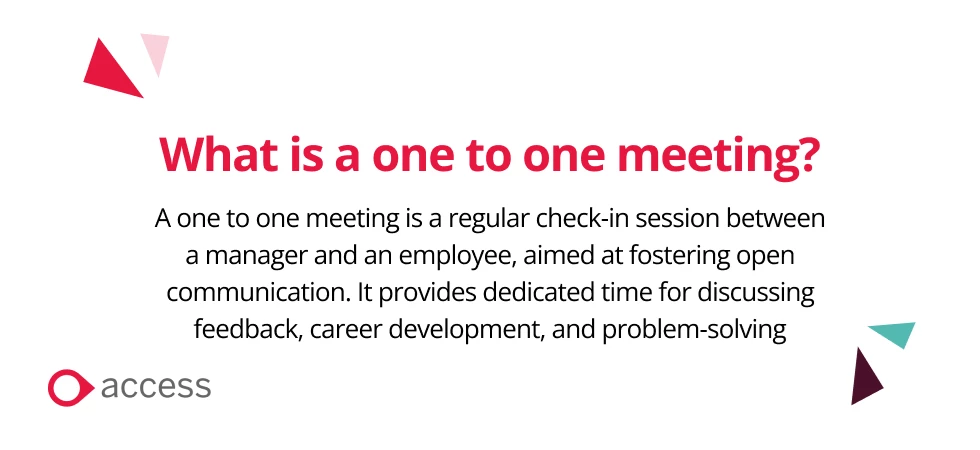
One-to-one meetings play a pivotal role in encouraging communication, trust, and productivity within businesses. In this article we are going to discuss what they are, what should be covered and how you can get the most out of them.
A one to one meeting is a planned check-in opportunity between managers and employees. It can be a chance to discuss career development, workload and performance goals, address any concerns or challenges, and provide feedback. Carrying out regular one to one meetings is a great way to connect with employees and help with their personal development.
Some companies choose to use Performance Management Software to help them with setting up and automating various aspects of one to one meetings with managers.
 Why are one to one’s important?
Why are one to one’s important?
One to one meetings are important as they provide dedicated time whereby communication between managers and employees is focused solely on the individual's progress, concerns, and development. For small businesses, this is especially crucial as it helps to build a strong rapport with staff which in turn improves job satisfaction and retention rates.
A recent report by the CIPD found that just under half of employees thought their manager supported their career development, highlighting a significant gap in communication and mentorship. When utilised correctly and carried out regularly, scheduled one to one meetings provide a structured platform for managers to actively engage with employees, understand their career aspirations, and provide guidance and support. This dedicated time also:
- Encourages communication and feedback exchange
- Increases employee engagement
- Identifies relevant development and training opportunities
How often should you have one to one meetings?
The frequency of a one to one meeting really depends on the schedule of the manager and employee, as well as how often both parties want to meet. Whatever is decided upon, set time should be put aside to dedicate to the 1to1 meeting.
Two popular meeting schedule options are monthly or bi-weekly, but this needs to be decided by those involved (unless you have a process in place) The cadence of the meetings will also help decide on the length of meetings – so more frequent meetings may be shorter in time than ones that occur on a monthly basis.
An important point to remember is to give this amount of time fully to the employee so they can get the most out of their one to one meetings. This also lets the employee know that their meeting is a priority and points will not be rushed through.
What should you cover in a one-to-one? Five discussion points:
While topics can vary depending on the needs of your business and the role of the employee, there are some points that should be covered. Below are five discussion points that should be raised in an employee’s one to one meeting with their manager.
1. Performance and progress
Discussing the performance and progress of the employee can be a good starting point to open up the one-to-one with. Consider the following points to build your discussion around:
- How is the employee doing? While a 121 meeting should be about their professional development, a check in on how they are feeling is important, especially as it will set the tone for the meeting.
- What have they actioned since the last meeting? Discuss ongoing projects and find out how they are managing their tasks.
- How are they progressing in their role? Are they feeling like they are doing well generally, meeting targets and completing tasks to a good cadence?
2. Workload and priorities
Next, talk about the employee’s workload and priorities to understand if additional support or resources are needed:
- Is their workload manageable? This will help a manager to understand if they may need to offer support or move priorities around where possible.
- What are their imminent priorities? This is an opportunity to check that current priorities align with company goals and personal KPIs. If this isn’t the case, it can be discussed further.
- What is on the horizon? Discuss upcoming projects with timescales so you can ensure that prioritising and planning is in place.
3. Challenges and roadblocks
Make time to talk about any challenges or roadblocks the employee is facing, with the following suggestions:
- Challenges faced: Discuss any challenges the employee has faced and how they have addressed them. Do they need additional support?
- Bottlenecks causing delays: If there are bottlenecks or roadblocks, let’s discuss strategies to overcome these. Are there other teams or people that can help get these over the line?
- Offer support: When an employee is unable to carry out tasks to completion due to roadblocks, it can be demoralising. Offer your support and find out if they require additional resources.
4. Feedback and recognition
Next, discuss any feedback you want to offer personally or on behalf of colleagues. This could include:
- Projects that have been completed since the last 121 meeting
- Overall contributions that align with company goals
- General feedback that can help shape future discussions
5. Final thoughts and wrap-up
The final step is to wrap the one to one meeting up with any final comments. What main points should be taken away with them, do you or they have any action points to follow up on? Ensure this is agreed and covered before the meeting is finished.
What are some good questions to ask your employee during a one to one?
Below some example questions you may want to ask your employee during a 121 meeting, grouped into the topics we have covered above.
Performance and Progress:
- "How do you feel about your performance since our last one-to-one meeting?
- Are there specific accomplishments or successes you've had recently that you're proud of?
- Are there any areas where you feel you could improve your performance and how can I help with this?
Workload and Priorities:
- How are you managing your workload currently?
- What are your top priorities, and are there any tasks or projects that you believe need to be looked at for reprioritisation?
- Do you feel any tasks are not aligned with your skillset or job role? If so, how can we adjust your workload?
Challenges and Roadblocks:
- Are there any bottlenecks that are stopping you from getting work completed?
- Do you feel supported with any challenges you have faced, and do you require any additional resources in order to deal with these effectively?
- What are the challenges faced in your work recently and how have you addressed them?
Feedback and Recognition:
- Do you feel you're receiving the right feedback on your work? Is there any area where you'd like more guidance?
- Is there anyone on the team whose contributions you believe deserve recognition?
- How can I improve in providing feedback and support to help you in your role?
What to do following a one-to-one meeting
While the 121 meeting itself and the structure of it is important, the steps you take post-meeting are equally as vital for employee growth and development.
Share notes
Sharing notes is a vital step once the one-to-one meeting has happened – both to encourage open communication and transparency, but also to keep track of progress and ensure everything is put in writing for future reference.
Request feedback
Following on from this, you should offer the employee a chance to offer feedback on the meeting including how they feel it went, communication styles and anything that should have been covered.
Plan for the next meeting
Lastly, you should take on board the feedback you have received and prepare for the next meeting. Store the notes so they can be added to and accessed for the next meeting and set up relevant reminders if you are using Performance Management Software.
How can PeopleHR help you get your one-to-one meetings right?
Our HR Performance Management Software can help you set up and manage your one to one meetings with ease.
Key features include:
- Online goal setting
- 360 feedback software
- Performance review templates
Get in touch with us If you want to find out more about how PeopleHR can help your business grow and succeed.